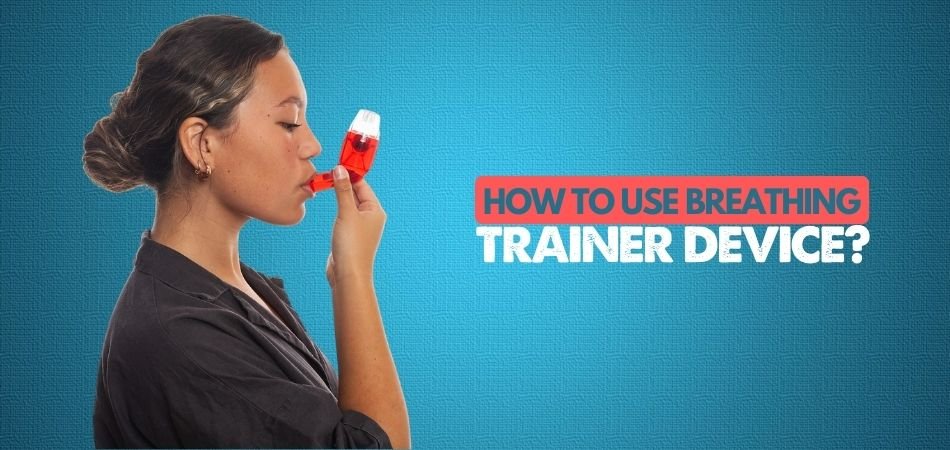Breathing trainer devices are small tools that can help your lungs work better over time. Many people use them daily to improve breathing strength or clear their airways more easily. If you’ve been thinking about trying one, you might already be wondering how to use breathing trainer device?
Use a breathing trainer by sitting up straight and setting the resistance. Seal your lips around the mouthpiece and breathe slowly. Hold your breath briefly if needed, then repeat for 10–25 breaths. Clean the device after each session. Regular use improves lung strength and airflow.
Want to know more about the steps or things you should avoid while using one? Are you curious about which device might be right for you? Keep reading, because this article includes all the key information you’ll need to use a breathing trainer the right way.
How to Use Breathing Trainer Device? – 7 Easy Steps
Breathing trainers may look small, but they can really help your lungs if you use them correctly. They’re simple to handle and can be added to your daily routine without much effort. With just a few steps, you can start improving how you breathe. If you’re not sure how to begin, don’t worry. This guide will walk you through it step by step.

Step 1: Get Ready First
Start by finding a place where you feel calm and comfortable. You can sit or stand, but make sure your back is straight. This will help your lungs open up better. Before using the trainer, check that it’s clean and put together the right way. Taking a few normal breaths before starting can help relax your body. Once you feel ready, move to the next step.
Step 2: Set the Resistance
Most breathing trainers come with resistance levels you can adjust. You should begin with a lower level if you’re new to this. Over time, as your breathing gets stronger, you can increase the level gradually. If you’re looking for a device that allows precise airflow control, then consider using the AirPhysio tool. It’s a simple, drug-free tool designed to clear mucus and help your lungs expand using something called OPEP—Oscillating Positive Expiratory Pressure.
Step 3: Fit the Mouthpiece
Now, place the mouthpiece gently into your mouth. Keep your lips closed tightly around it to stop any air from escaping. Your teeth should not bite down on it—just hold it in place with your lips. A tight seal helps the trainer work the right way. If it feels loose, adjust your grip or posture. Make sure you feel okay before moving to the next step.
Step 4: Start Breathing
Follow the device instructions to know if you should breathe in or out. Take a slow and steady breath, not a fast one. Try not to move your shoulders—let your lungs do the work. Breathe through the device the same way each time. If you feel tired, take a short break before starting again. It is important to repeat this exercise until you have taken the right number of breaths.
Step 5: Hold Your Breath
Some trainers ask you to hold your breath for a few seconds after you breathe in or out. This is usually about 2 to 3 seconds. It helps your lungs stay open longer and makes the session more useful. Don’t hold your breath too long or force yourself. Just stay relaxed and follow the instructions. With practice, you will be able to accomplish this step more easily.
Step 6: Repeat the Process
Each session should have about 10 to 25 breaths. You can do this once or up to four times a day, depending on how you feel. Don’t try to do too much at once—listen to your body. Spread the sessions throughout the day if needed. By doing it daily, you will be able to strengthen your lungs over time. The more consistent you are, the better your results will be.
Step 7: Clean After Use
After your workout is over, make sure you clean your trainer as soon as possible. Use warm, soapy water and rinse it thoroughly. You will need to let the trainer dry in the open air—don’t use a towel. Cleaning keeps it free from germs and keeps it functioning properly. If you keep your trainer dirty, you can have problems the next time you use it. Make sure you always store it in a dry, safe place.
Using a breathing trainer the right way can make a big difference in your daily life. Just follow these easy steps and keep your device clean. Stay patient, and you’ll see the results over time. Good breathing can help you feel more active and relaxed every day.
Why Should You Follow Proper Breathing Techniques?
We all breathe every day without thinking about it. But how you breathe can actually affect how your body feels and works. Many people use the wrong way of breathing when they feel stressed or tired. If you want to feel better, check out the info below.
Better Oxygen Flow
Breathing the right way helps your body get the oxygen it needs. Your heart and lungs work better when oxygen moves smoothly. This means you feel less tired even after doing small things. It also helps your brain stay sharp and active. If you have bad breathing habits, you may feel weak or dizzy as a result. Keeping your body in good condition all day long starts with breathing properly.
Calmer Mind
When you’re upset or nervous, your breathing often becomes fast and shallow. Slowing it down can help you feel more relaxed. Breathing deeply tells your brain that everything is okay. That’s why people use breathing to stay calm during tough moments. It’s a simple way to control your feelings without any medicine. Over time, your mind learns to stay calm more easily.
Stronger Breathing Muscles
Your body uses certain muscles every time you take a breath. These muscles can become stronger with regular practice. Some people even check the effectiveness of breathing trainer tools to improve their breathing strength. A little effort each day can make your lungs work better. You will find it easier to talk, run, or even climb stairs. This happens because your breathing muscles are more prepared.
Better Sleep Quality
Good breathing before sleep helps you fall asleep faster. When your body gets more oxygen, your brain also relaxes. People who breathe properly at night sleep longer and feel more rested. Shallow or uneven breathing can disturb your sleep without you knowing. Breathing deeply while lying down can calm your body. This makes it easier to enjoy deep, peaceful sleep.
More Energy Daily
Whenever you breathe well, your body gets more energy to go about doing its work. When you breathe properly, you’ll feel energetic and ready rather than sleepy or slow. Proper breathing helps your body conserve its energy and use it effectively. Even small tasks won’t be as difficult anymore. You can feel fresh from morning until evening. This is one of the best ways to feel more alive every day you wake up.
Changing how you breathe can make your days easier and healthier. You don’t need special training to start—just a bit of practice. Try these simple ideas and feel the results for yourself. Healthy breathing is a habit worth building.
Common Mistakes to Avoid While Using Breathing Trainers
Using a breathing trainer can be a smart way to help your lungs get stronger. But many people use it the wrong way without even knowing. These small mistakes can stop you from getting good results. Let’s go through what to avoid so you can use it the right way.

Skipping Instructions
It’s easy to feel like you don’t need instructions, but that’s where many people go wrong. Breathing trainers are not all the same, and using them without checking the guide can reduce their benefits. Some devices are for inhaling, while others are for exhaling. If you mix them up, you won’t get the right result. Always check the instructions or watch a short video before using one. It helps you understand how to use it safely and properly.
Wrong Body Posture
If your posture is bad, your lungs can’t work as well as they should. Slouching or bending your back can block smooth airflow. Sit up straight, relax your neck, and keep your shoulders down. This helps air move in and out of your lungs more freely. Good posture also makes each breath with the trainer more useful. The right body position makes a big difference over time.
Overdoing the Practice
Many people think that more practice means faster results, but that’s not true with breathing trainers. Using them too much can make your muscles tired or even cause discomfort. Your breathing muscles need time to rest, just like your arms or legs after a workout. Stick to short sessions a few times a day. Always take breaks in between to let your body recover. Slow and steady use works better than rushing.
Not Cleaning the Device
Using the breathing trainer without cleaning it can cause problems. Over time, dust, dirt, or spit can build up inside the device. This makes it less safe and less effective. You should wash it with warm water and mild soap after each use. Let it dry fully before using it again. A clean device helps you breathe better and keeps you healthy.
Ignoring Progress Signs
If you’ve been using a breathing trainer for weeks but feel no change, that’s a sign something’s off. Maybe you’re not using it the right way, or your sessions are too short or too long. Some people push themselves too hard and get tired instead of getting stronger. Keep track of how you feel after each session. If something feels wrong, it’s okay to take a break or ask someone for help. Noticing progress is part of using the tool correctly.
Breathing trainers can help a lot when used the right way. But using them wrong can slow your improvement or even make you feel worse. Small habits, like posture and cleaning, really matter. Stay careful and consistent, and you’ll see better breathing results over time.
What Should I Know Before Choosing a Breathing Trainer Device?
Some people use breathing tools to feel better, and others use them to help during workouts. These devices can make breathing easier and stronger over time. But not all breathing trainers work the same way. Let’s find out what you should look for before picking one.

Know Your Purpose
People buy breathing trainers for different reasons. Some want help with lung strength, while others need it after feeling unwell. If you know why you need one, it’s easier to choose the right type. Picking the wrong one might not help at all. You can also ask a doctor if you’re unsure. A clear goal makes the decision easier and smarter.
Device Type Matters
Breathing devices come in many forms, and each one works in its own way. A good example is an OPEP device, which helps clear the lungs using gentle pressure. After hearing about its benefits, many people try using OPEP device models as a next step. These tools often give extra support for people with breathing problems. It’s helpful to learn how each type works. That way, you can match the device with what your body needs.
Check for Comfort
It’s important that the tool feels nice in your mouth when you use it. If it feels too tight or rough, you may stop using it after a few tries. A soft, smooth mouthpiece makes it easier to breathe through. Some trainers let you adjust the fit, which is a bonus. Using something comfortable makes the routine more enjoyable. When it feels right, you’ll want to use it more often.
Ease of Cleaning
Breathing devices need regular cleaning to stay safe and useful. If it’s hard to clean, you might avoid using it. Choose one that comes apart easily and doesn’t take too much time to rinse. A cleaner tool works better and keeps you safe from germs. If it has too many parts, it might be difficult to clean if it has a lot of them. Simple designs are usually better for daily use.
Start with Simple
Trying a basic tool first is a smart idea. It helps you understand how breathing trainers work without spending too much. Once you get used to it, you can try more advanced versions later. Expensive models are not always better for beginners. Using simple ones gives good results and they are easier to use than complicated ones. Starting small often leads to better long-term habits.
Choosing the right breathing trainer takes a little thinking but it’s worth it. The better it fits your needs, the more likely you’ll use it often. Start with something easy and build from there. A smart choice can make breathing easier every day.
FAQs about How to Use Breathing Trainer Device?
Here’s a quick FAQ section to help clear up some common questions people have about using breathing trainer devices. Even if you’ve read the full guide, these answers can give you more help for small things you might still be unsure about. Each answer is simple, clear, and useful for daily practice. Let’s go over them so you can feel even more confident using your device.
Can I Use a Breathing Trainer Before Exercise?
Yes, you can use a breathing trainer before doing physical activities. It helps open up your lungs so you can breathe more easily while moving. Just make sure to do a short session and not push too hard. If you feel tired or out of breath, take a break before starting your main exercise.
How Long Should Each Breathing Session Be?
A typical breathing session should last between 5 to 10 minutes. Start with a shorter time if you’re new to it, and increase slowly as you feel more comfortable. Don’t try to rush or go beyond your limit. If you start feeling dizzy or tired, it’s okay to stop and try again later.
Should I Use the Device Daily?
Yes, using the device every day can give you better results. Like any habit, breathing exercises work best when you stay consistent. You don’t have to do long sessions—just keep it regular. Missing a day once in a while is fine, but try not to skip too often.
Can Children Use Breathing Trainers?
Children can use breathing trainers, but only special ones made for them. Not all devices are safe for kids, especially those with high resistance. Always check the label or talk to a doctor before giving it to a child. It’s important that the size and settings match their needs.
Is It Normal to Cough While Using It?
Yes, light coughing can happen during or after using a breathing trainer. This is sometimes a sign that mucus is being cleared out of your lungs. As long as the cough goes away soon, it’s usually nothing to worry about. But if you keep coughing or feel unwell, it’s better to stop and get help.
Can I Lie Down While Using It?
It’s not a good idea to lie down when using a breathing trainer. Your lungs work better when you’re sitting or standing with your back straight. This way, air moves more freely in and out. Use a chair with back support to stay comfortable during your session.
What If I Don’t Feel a Change?
Sometimes, results take a little time to show. If you don’t feel different after a week or two, check if you’re using the device correctly. You might need to change the resistance level or improve your posture. Even small changes in how you use it can make a big difference.
Do I Need to Warm Up Before Using It?
Yes, it’s a good idea to take a few deep breaths before you begin your session. This helps your lungs get ready and makes the exercise feel smoother. Warming up also helps reduce sudden coughing or discomfort. It only takes a minute and makes your practice more comfortable.
Can I Share My Device With Others?
No, you should never share your breathing trainer with someone else. Even if you clean it, germs can still stay inside and spread sickness. Everyone should have their own device for safety. Sharing is not safe when it comes to health tools like this.
What Should I Do If It Feels Uncomfortable?
If using the device feels weird or hurts, stop right away. Check the mouthpiece and your posture to see if something is wrong. Sometimes the device isn’t the right size or shape for you. If it still feels bad after adjusting, try using a different model that suits you better.
End Note
Breathing trainers can make a real difference when used the right way. From sitting straight to cleaning your tool after use, each step helps your lungs get stronger. If you’ve been wondering how to use breathing trainer device?—it simply involves steady breathing, following easy steps, and staying consistent with your practice.
Now that you know the basics, try to avoid common mistakes like poor posture or skipping cleaning. Start slow, listen to your body, and keep your device in good condition. With time and care, breathing better can become a daily habit. Wishing you all the best as you take your first steps toward stronger and easier breathing!






